42 reading food labels diabetes
Reading food labels & nutrition panel - Diabetes Queensland Reading food labels When choosing packaged food, choose products with: lower energy (kilojoules) if you are trying to lose weight lower total and saturated fat lower sugar lower sodium higher fibre Every food label tells a story and the Nutrition Information Panel simply gives you the facts. Understanding food labels | Diabetes UK Check the ingredients list - if syrup, invert syrup, cane sugar, molasses or anything ending in 'ose' is within the first three ingredients, this suggests the food contains more added sugar. Choose an alternative if possible, or be mindful of the portion you eat. Check the fibre content on the back of pack label.
How to Read the New Food Label - The Johns Hopkins Patient Guide to ... Carbohydrates raise blood glucose, so this part of the food label is most familiar to people with diabetes. Total carbohydrates include starches, fiber, sugars, and sugar alcohols. If you are counting carbohydrates, count total carbohydrates in grams. Look for foods with fiber which helps to slow the rise in glucose.

Reading food labels diabetes
diabetes.org › healthy-food-choices-made-easyHealthy Food Choices Made Easy - American Diabetes Association Recipes from Diabetes Food Hub® Eating Well; Reading Food Labels; Vitamins & Diabetes; Behavior Change & Weight Loss . Getting Started: Back to Basics; Problem Solving to Improve Diabetes Management; Eating Tips Before and After Exercise; Make a Difference with Positive Self-Talk; Take Charge: Emotions and Eating; Fitness. Getting Started Safely Understanding food labels - Diabetes Ireland • It is high in sugar - it contains 25g per 100g of food. • It is low in fat - it contains 2.5g of fat per 100g, which is less than the low fat cut-off of 3g per 100g • Contain a 'source' of fibre - it contains 3.4g of fibre which is greater than the 'source' of fibre cut off of 3g per 100g. Reading Food Labels When You Have Diabetes | HealthLink BC Start with the "% Daily Value" column on the food label. A food is considered low in a specific nutrient (such as fat, saturated fat, cholesterol, carbohydrate, or sodium) if it has 5% or less of the daily value. A food is considered high in that nutrient if it has 15% or more of the daily value. Watch out for health claims on food labels. Just because a food has a health claim doesn't mean it is good for you.
Reading food labels diabetes. Reading Food Labels, The Most Basic Tool in Diabetes Management What are the 6 steps to reading food labels? Step 1: Examine serving sizes and calorie counts per serving. The serving size determines all of the information on a food label. Keep in mind that one serving may be significantly smaller than you believe. For example, if you eat two portions, you've consumed twice as many calories, fat, and salt. Reading labels | Diabetes UK Key points. Always look at the 'total carbohydrate' on the label when carb counting. This will make sure you are counting both the complex (starchy) and simple (sugary) carbs in your food. Both will raise your blood glucose (blood sugar) levels, and need to be matched with insulin. In general, sugar-free options like diet drinks and jellies don't ... Decoding Diabetes: How to Read Nutrition Labels | Accu-Chek Nutrition labels are typically made based on the assumption that you have a daily diet of 2,000 calories (kilocalories). Some labels will have a footnote that expand on this concept, providing numbers for both 2,000 and 2,500-calorie (kilocalorie) diets. In between the line on a nutritional label for calories (kilocalories) and the footnote at ... PDF Label reading basics for diabetes - Veterans Affairs • This food has 8 grams of fat per 2/3 cup serving. • A food is considered low fat if it has 3 grams of fat or less for every 100 calories. • Limit saturated fat to 1 gram or less for every 100 calories. • Avoid trans fats. Sodium • Indicates the total amount of salt in one serving of this product. • This food has 160mg of sodium
Understanding food labels fact sheet - NDSS Understanding how to read food labels can help you choose foods with more fibre and less saturated fat, salt (sodium), added sugars and kilojoules. Food labels will typically include a nutrition information panel, list of ingredients, the 'use by' or 'best before' date and identify potential food allergens and additives. Food labels also tell you the amount of carbohydrates (carbs) you eat and drink. This can help you manage your blood glucose levels. Read more in our fact sheet ... diabetes.org › reading-food-labelsReading Food Labels | ADA - American Diabetes Association Understanding Food Labels It's time to decode those food claims. Trying to figure out nutritional information on labels and packaging isn't easy. The good news is that we can help. Untangle packaging claims. If you get tripped up on food content claims, you're not alone. Fat free vs. low fat vs. reduced fat. Low cholesterol vs. reduced cholesterol. Reading Food Labels | ADA - American Diabetes Association Reading labels can help you find these hidden sources and compare the sodium in different foods. Whether you have diabetes or not, 2300 milligrams (mg) or less per day is the general recommendation. If you have high blood pressure, talk with your health care team to find out the best goal for you. List of ingredients Reading Food Labels to manage Diabetes - Making Diabetes Easier When reading food labels, it is important to understand the difference between simple and complex sugars, as their effect on blood glucose levels is not the same: Simple, or "fast", sugars have a high glycaemic index and will therefore be rapidly digested, which can cause hyperglycaemia.
› food-labels › art-20047648Reading food labels: Tips if you have diabetes - Mayo Clinic Jun 25, 2021 · If your meal plan is based on carbohydrate counting, food labels become an essential tool. Look at total carbohydrates, not just sugar. Evaluate the grams of total carbohydrates — which include sugar, such as added sugars; complex carbohydrates; and fiber — rather than only the grams of sugar. › diseases-conditions › diabetesDiabetes - Diagnosis and treatment - Mayo Clinic Aug 09, 2022 · A reading of more than 200 mg/dL (11.1 mmol/L) after two hours means you have diabetes. A reading between 140 and 199 mg/dL (7.8 mmol/L and 11.0 mmol/L) means you have prediabetes. If your provider thinks you may have type 1 diabetes, they may test your urine to look for the presence of ketones. catinfo.orgFeeding Your Cat: Know the Basics of Feline Nutrition ... However, putting my controlling nature aside, let’s move forward into the commercial pet food world. When reading this section, two words need to be firmly in your mind: composition (the percentage of protein, fat, and carbohydrate in the food) ingredients; Unfortunately, pet food labels are not held to the same standard as human food labels. Food label reading guide | Nutrition Australia What to look for when reading food and drink labels (per 100g) Health Star Ratings The Health Star Rating is a front of pack labelling scheme which can be used to make healthier food choices at a glance. The rating range is from ½ - 5 stars and the more stars, the healthier the choice. Recommended minimum star ratings for food and drink categories
Diabetes and Food Labelling - Diabetic Food, Traffic Light Labels and GDA The idea of traffic labelling is to help people make quick assessments of whether foods are good choices or not. Unfortunately, the traffic light system is not a reliable indicator of food health. For example, the system gives any food high in fat a red light. This means that natural, healthy sources of fat such as cheese, nuts and avocados get ...
Guide to Reading Food Labels with Diabetes | Better Health Kare As another good tip, when reading food labels with diabetes disease, pay attention to high-fiber foods. Fiber is the best ally for diabetic patients is it helps reduce the absorption of simple carbohydrate s. Try to stick to foods that contain at least 3 grams of fiber per serving. It is also important to remember that when the ADA recommends ...
Learning To Read Labels :: Diabetes Education Online When you read food labels, the grams of sugar are already included in the total carbohydrate amount, so you do not need to count this sugar amount separately. The grams of sugar listed include both natural sugars, from fruit or milk, and added sugars. On a nutrition food label, the total carbohydrate includes the sugar.
Food Labels | CDC - Centers for Disease Control and Prevention If you eat the whole thing, you are eating 8 times the amount of calories, carbs, fat, etc., shown on the label. Total Carbohydrate shows you types of carbs in the food, including sugar and fiber. Choose foods with more fiber, vitamins, and minerals. Choose foods with lower calories, saturated fat, sodium, and added sugars. Avoid trans fat.
Reading food labels: Tips if you have diabetes - Drugs.com Just as food labels can help you avoid certain foods, food labels can also serve as your guide to free foods. A free food is one with: Fewer than 20 calories a serving; Less than 5 grams of carbohydrates a serving; Do the math. Pay attention to serving sizes. The serving sizes listed on food labels may be different from the serving sizes in ...
Reading Food Labels When You Have Diabetes - Alberta A food is considered low in saturated fat if it has 5% or less of the daily value. A food is considered high in saturated fat if it has 15% or more of the daily value. Cholesterol is listed below the fats on the food label. Aim to eat less than a total of 300 mg of cholesterol a day. Saturated fat, trans fat, and cholesterol increase your risk ...
Reading Food Labels for Carbohydrates - dummies Reading food labels is a vital skill for anyone who counts carbohydrates. To find the amount of carbohydrates in your foods, follow these steps: ... Some people with diabetes who are counting carbohydrates can subtract the grams of Dietary Fiber — listed under Total Carbohydrate on the food label — from the grams of Total Carbohydrate ...
Food Labels | Know Diabetes This food will be high in fat, saturates, salt or sugar. These are fine to have occasionally but you should try to avoid choosing foods with red on the label too often. Amber= Medium This means neither high nor low, so foods with all or mostly amber on the label are fine most of the time. Green= Low
How to Read Food Labels When You Are Diabetic - Diabetics Weekly Study the Carbohydrate Content in Detail This is the most important aspect of how to read food labels when you have diabetes. The total amount of carbohydrates breaks down into complex carbohydrates, sugar, and fiber. Don't hone in on zero-sugar foods, as foods like milk and fruit contain natural sugars.
diabetes.org › healthy-living › recipes-nutritionFats | ADA - American Diabetes Association American Diabetes Association. 2451 Crystal Drive, Suite 900 Arlington, VA 22202. For donations by mail: P.O. Box 7023 Merrifield, VA 22116-7023. 1-800-DIABETES
Diabetes Food Label Reading: Quick Tips to Shop Smarter Read the actual food label - the ingredients list and the nutrition facts panel. We recommend skimming the back label and keeping your eyes open for sugar and sugar alternatives that might be hiding somewhere in the ingredients list.
PDF TO CARE 4 YOURSELF READING A NUTRITION FACTS LABEL - novoMEDLINK diabetes and prediabetes.1 When we think of sodium sources, we often think of table salt. But many of the foods we eat contain sodium. Reading the label can help you compare the amount of sodium in foods so that you can choose lower-sodium options. Nutrition Facts 8 servings per container Serving size 2/3 cup (55g) Calories 230 5% 10% 0% 7% 13% ...
Food Labels and How to Read Them - Diabetesnet.com For those with diabetes, food labels are extremely helpful for carb counting and for determining appropriate insulin doses for these foods. What consumers get from food labels: nutrition information about almost every food in the grocery store; an easy-to-read format that enable consumers to more quickly find the information they need to make ...
How to read food labels if I have diabetes or prediabetes? Knowing how to read food labels is a very useful skill to improve your eating and better manage or help to prevent the progression of diabetes. There are three main things on the food labels to look out for: nutrition information panel, ingredient list, and Healthier Choice Symbols. 1. Nutrition information panel (NIP)
How to read food labels | Diabetes Victoria 1300 437 386 Contact us. NDSS Helpline 1800 637 700. DIABETES & ME. HOW WE HELP. GET INVOLVED. DONATE. SHOP. BECOME A MEMBER. MEMBER LOGIN.
› diseases-conditions › diabetesDiabetes and exercise: When to monitor your blood sugar Jan 20, 2022 · Reading food labels; Resperate: Can it help reduce blood pressure? Sleep deprivation: A cause of high blood pressure? Blood sugar testing; Stress and high blood pressure; The dawn phenomenon: What can you do? Unexplained weight loss; Vasodilators; Vegetarian diet: Can it help me control my diabetes? How diabetes affects your blood sugar
Reading Food Labels When You Have Diabetes | HealthLink BC Start with the "% Daily Value" column on the food label. A food is considered low in a specific nutrient (such as fat, saturated fat, cholesterol, carbohydrate, or sodium) if it has 5% or less of the daily value. A food is considered high in that nutrient if it has 15% or more of the daily value. Watch out for health claims on food labels. Just because a food has a health claim doesn't mean it is good for you.
Understanding food labels - Diabetes Ireland • It is high in sugar - it contains 25g per 100g of food. • It is low in fat - it contains 2.5g of fat per 100g, which is less than the low fat cut-off of 3g per 100g • Contain a 'source' of fibre - it contains 3.4g of fibre which is greater than the 'source' of fibre cut off of 3g per 100g.
diabetes.org › healthy-food-choices-made-easyHealthy Food Choices Made Easy - American Diabetes Association Recipes from Diabetes Food Hub® Eating Well; Reading Food Labels; Vitamins & Diabetes; Behavior Change & Weight Loss . Getting Started: Back to Basics; Problem Solving to Improve Diabetes Management; Eating Tips Before and After Exercise; Make a Difference with Positive Self-Talk; Take Charge: Emotions and Eating; Fitness. Getting Started Safely

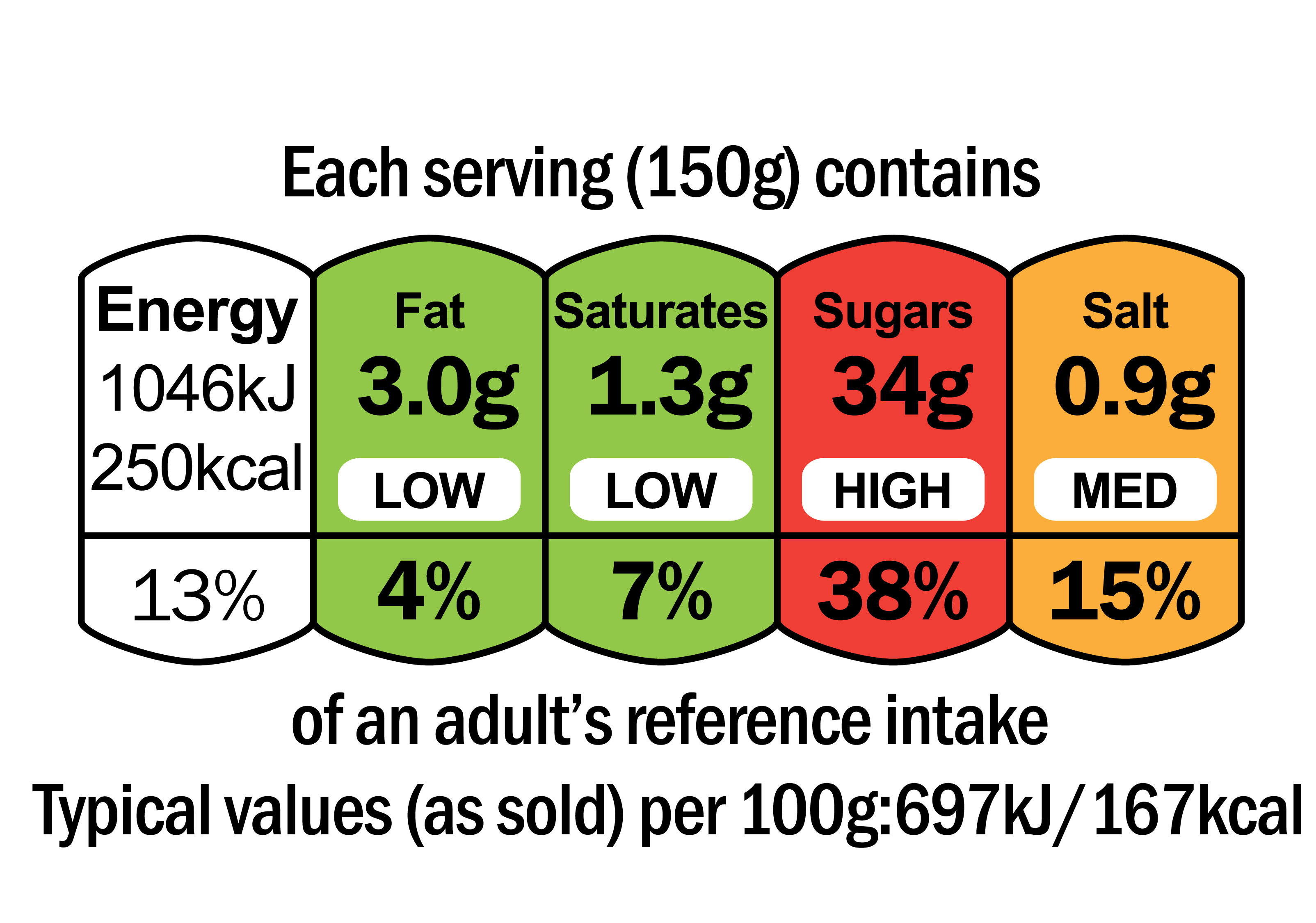
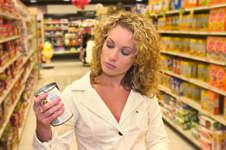






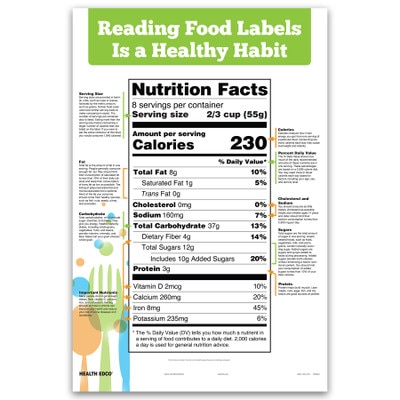






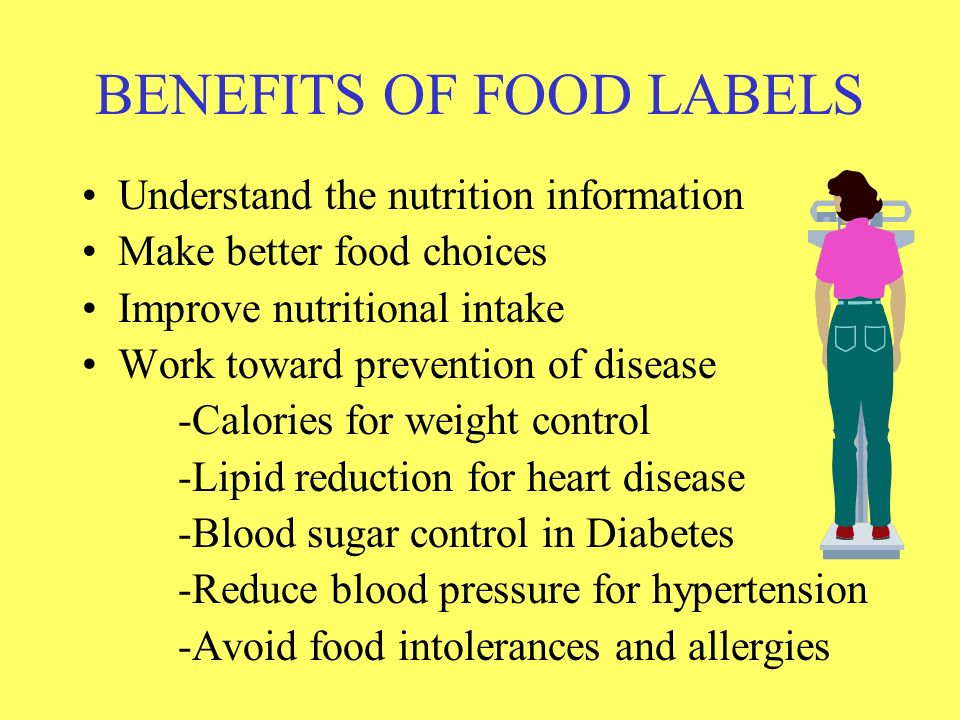

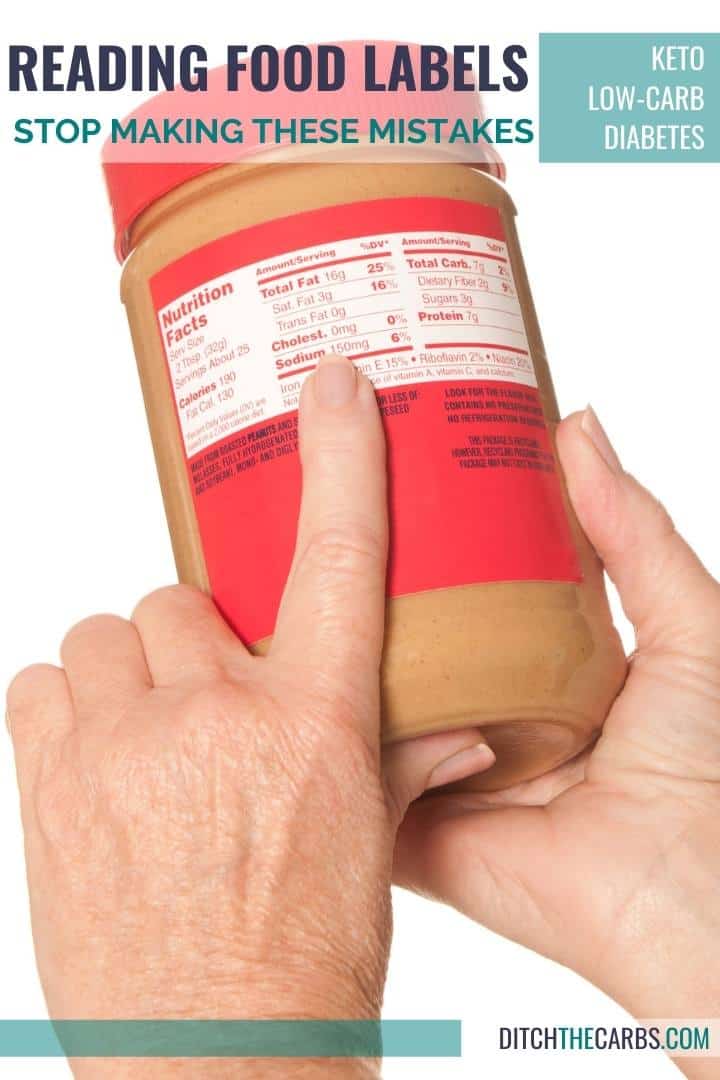
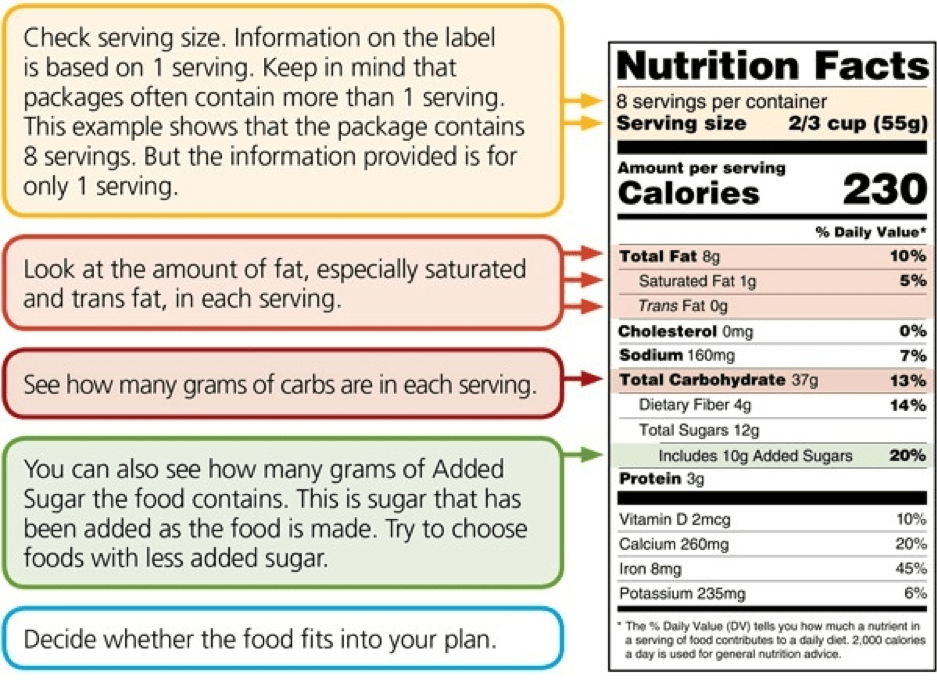

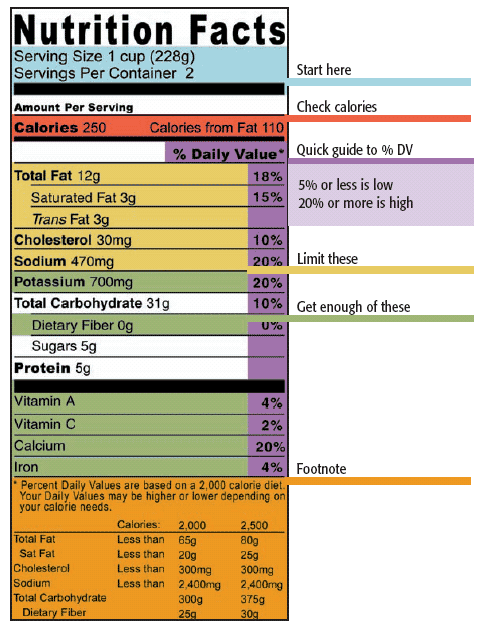


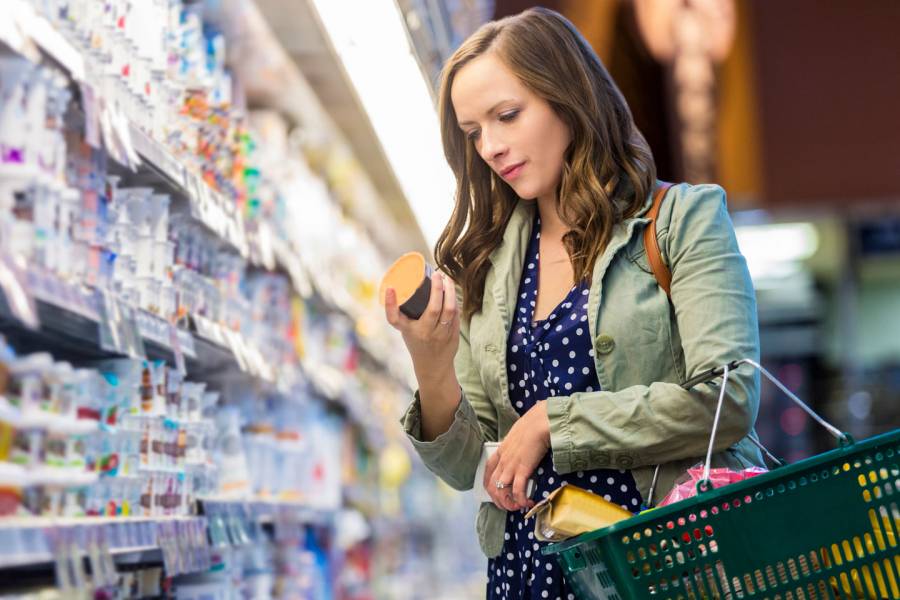



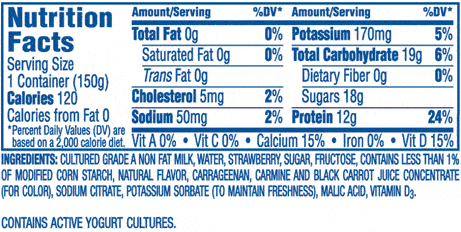






Post a Comment for "42 reading food labels diabetes"